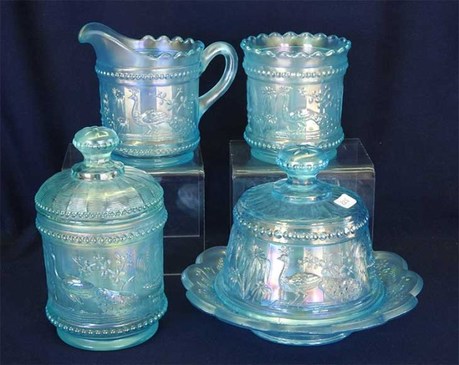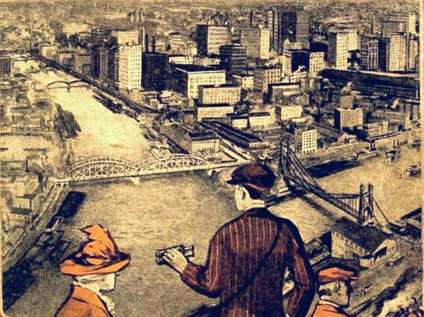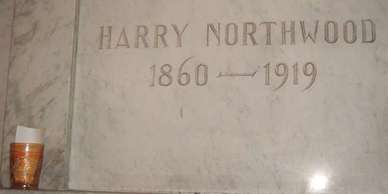Harry Northwood - Triumph and Tragedy (Part Three)
In Part One we looked at how a new and potentially profitable niche had opened in the market for the production of glass lampshades and associated items, for the new electric lighting, and how one glassmaker, Macbeth-Evans, invented a translucent style of glass, "Alba", to exploit this massive new market. In Part Two we focused on Harry Northwood's response - his own version of this type of glass, which he called Luna.
Here in Part Three, we look at the outcome of Harry's big mistake and his dispute with Macbeth-Evans over the formula for Alba / Luna glass.
Alba formula patented
In May 1914, Macbeth-Evans had been granted a patent for their Alba glass, and this gave Harry a major problem. He was using the Macbeth-Evans glass formula for his Luna glass (as were most of the other glass firms) and also some of Harry's other major lines, including his "Marble Glass".
Harry was no stranger to registering patents for his ideas (he’d done so several times - see his Peacock at the Fountain Patent, later on this page) so he was well aware of the implications of the Macbeth-Evans 1914 patent.
An amazing piece of archive correspondence has surfaced that we can show you here, courtesy of Scott Beale. It is a letter, written on November 1914, from Harry Northwood to his brother-in-law, Percy Beaumont (also a glass firm owner, who was making illuminating ware). In the letter, Harry is clearly wondering what to do. Should he agree to a license from Macbeth-Evans to use their Alba glass formula, and pay them royalties for using it? Or should he just carry on using the formula, and perhaps hold out for better terms?
Harry said in his letter that he did not want to be seen as a "trouble starter", and that he had promised to give Macbeth-Evans his answer “by Wednesday of this week” – and that’s what he did. Just two days after writing this letter, Harry agreed a financial arrangement for a license with Macbeth-Evans. It was a four year deal, with an initial payment of $3000 and a promise to pay $5,500 (calculated as a percentage of what the sales of Northwood’s Luna glass were likely to be).
|
That should have been the end of the matter - but it wasn't! The $5,500 wasn’t paid (around $130,000 today). Harry reneged on the license agreement, possibly because a Macbeth-Evans lawsuit against another glass firm had failed, and Harry felt that they wouldn’t pursue him for the outstanding sum. On the face of it, all was going well. The market was also growing rapidly. The Mazda Lamps ad on the right was in a 1914 Butler Brothers catalogue. Compared with the first ads in 1910-1911, the range of bulbs had expanded, but more importantly, the price had dropped from 75c / $1.25 to 23c / 58c each. Pittsburgh held its annual Glass Exposition each year in January. It was the opportunity for glass firms to promote their new lines. In 1916, H. Northwood Company had a major display, taking out large ads in the glass trade journals such as the one above in the “Crockery and Glass Journal”, January 1916.
|
The lack of ads for Northwood's Carnival Glass in Butler Brothers wholesale catalogue, and elsewhere, strongly suggest that Harry's attention had moved on and was focused on lighting, and on other styles of glass, such as his "Marble Glass" (or "Brecciated Marble"), which used the same base glass formula as Luna.
|
The last ad for Northwood Carnival that we can find in Butler Brothers is from June 1917, as shown on the right. It shows his Peacock at the Fountain range - note that this is the actual name given to the pattern in the ad. It was offered in "florentine iridescent". As we have said before, Harry Northwood was no stranger to the Patent system, using it to protect some of his designs for glass patterns and apparatus. Peacock at the Fountain was one of the designs that Northwood had patented - in July 1914 (shown below, right) - but as we know, it didn't work, and the pattern was also produced by Dugan-Diamond. Strange then that he initially ignored Macbeth-Evan's patent for Alba, and then he didn't honour the license agreement to use it. |
A breathtaking lawsuit
The $5,500 that Northwood owed to Macbeth-Evans was unpaid, and in September 1917 Macbeth-Evans filed suit against Northwood for the defaulted license payment. Calculated with interest, the settlement against Northwood was $36,000. It doesn't sound like a lot, but it was the equivalent of a breathtaking sum of around $860,000 today (a little more or a little less). Harry Northwood was being sued for an amount equivalent to just under a million dollars!
To put it into context for Harry's business, the $36,000 he was being sued for was more or less the same as his entire year’s profit. That amount would literally wipe out the annual profit of H. Northwood & Co. Harry and his younger brother, Carl (who was in charge of sales at the Northwood firm) must have been stunned by that amount. To think that by not paying the $5,500 that Harry had agreed to back in 1914, they were now being sued for $36,000, which would obliterate their yearly profits at a stroke. It must have been a devastating blow for them. One can only imagine the incredible stress the two brothers must have been suffering from the profound shock.
And then tragedy at the 1918 Pittsburgh Glass Expo.
Every year in January, Pittsburgh held its annual Glass Exposition, using several of the city’s prestigious hotels to host the event. It was an important occasion where all the glass firms showcased and promoted their new lines. Harry Northwood had always had a major display at the Pittsburgh Glass Expo. - in 1918, Carl attended as usual (in his role as salesman), but Northwood did not have its own dedicated stand. Perhaps they were trying to save money and cut costs in view of the huge amount they were being sued for. Certainly they needed to push for more sales.
A week into the event tragedy struck – Carl Northwood collapsed on the street outside the Fort Pitt Hotel and died on the 15th. January 1918, on his way to hospital in an ambulance. He was just forty six years old. One report says he had been suffering from a cold, another mentions “acute indigestion”, while his actual death certificate states “acute nephritis” and “gastro hemorrheges” (sic). One can only wonder if the stress of the lawsuit and the vast amount of money they were being sued for, had been preying on his mind – especially as Macbeth-Evans were present at the Glass Expo., and it’s highly likely that it would have been a topic of conversation among many of the exhibitors.
Just a few months later, Harry Northwood also became ill. He died at 10:50 in the evening on the 4th February 1919, a year after his brother. The cause of death was given as “liver trouble”. Harry was just fifty-eight years old.
The Northwood firm carried on, as well as it could, after the loss of Harry – but without his enormous personality and genius driving it forward, things were never the same. There were financial difficulties (including the Macbeth-Evans suit, in respect of which the amount of $36,000 rose to $42,500) and the company ultimately went into receivership, finally closing in 1925.
Just a few months later, Harry Northwood also became ill. He died at 10:50 in the evening on the 4th February 1919, a year after his brother. The cause of death was given as “liver trouble”. Harry was just fifty-eight years old.
The Northwood firm carried on, as well as it could, after the loss of Harry – but without his enormous personality and genius driving it forward, things were never the same. There were financial difficulties (including the Macbeth-Evans suit, in respect of which the amount of $36,000 rose to $42,500) and the company ultimately went into receivership, finally closing in 1925.
|
Both Carl's and Harry's Death Certificates are public records, and we have shown them on a separate page.
Here is the link: Northwood Death Certificates. Much has been written about Harry Northwood’s final years, and his lengthy obituaries have been re-published many times. However, we would like to present something else to you, as a final tribute to Harry - the touching photo on the right, courtesy of Carla Tustin. It is from Greenwood Cemetery, Wheeling, where Harry is interred. As you can see, a single marigold Grape and Cable tumbler sits evocatively by his memorial stone. We don’t know what is written on the paper that is tucked inside it. |
Acknowledgements and references
Sincere thanks to:
Scott Beale for allowing us to reproduce the 1914 letter from Harry Northwood to Percy Beaumont.
Phil Prince for the images of the Death Certificates of Harry and Carl Northwood, and other archive extracts.
Greg Dilian for the images of his Luna shades.
Harry Northwood, the Wheeling Years: 1991. Heacock, Measell and Wiggins.
Crockery and Glass Journal.
Glass and Brass Salesman.
Shades and Globes catalogue, Macbeth-Evans, 1912.
Ornamental Street Lighting and Alba Globes catalogue, Macbeth-Evans, 1912.
Illuminating Glass catalogue, Northwood, 1913.
Sincere thanks to:
Scott Beale for allowing us to reproduce the 1914 letter from Harry Northwood to Percy Beaumont.
Phil Prince for the images of the Death Certificates of Harry and Carl Northwood, and other archive extracts.
Greg Dilian for the images of his Luna shades.
Harry Northwood, the Wheeling Years: 1991. Heacock, Measell and Wiggins.
Crockery and Glass Journal.
Glass and Brass Salesman.
Shades and Globes catalogue, Macbeth-Evans, 1912.
Ornamental Street Lighting and Alba Globes catalogue, Macbeth-Evans, 1912.
Illuminating Glass catalogue, Northwood, 1913.










